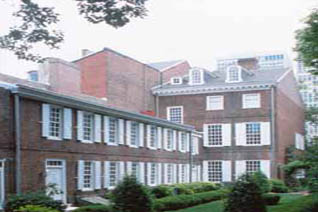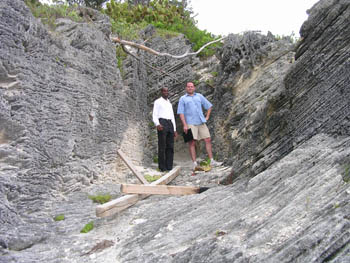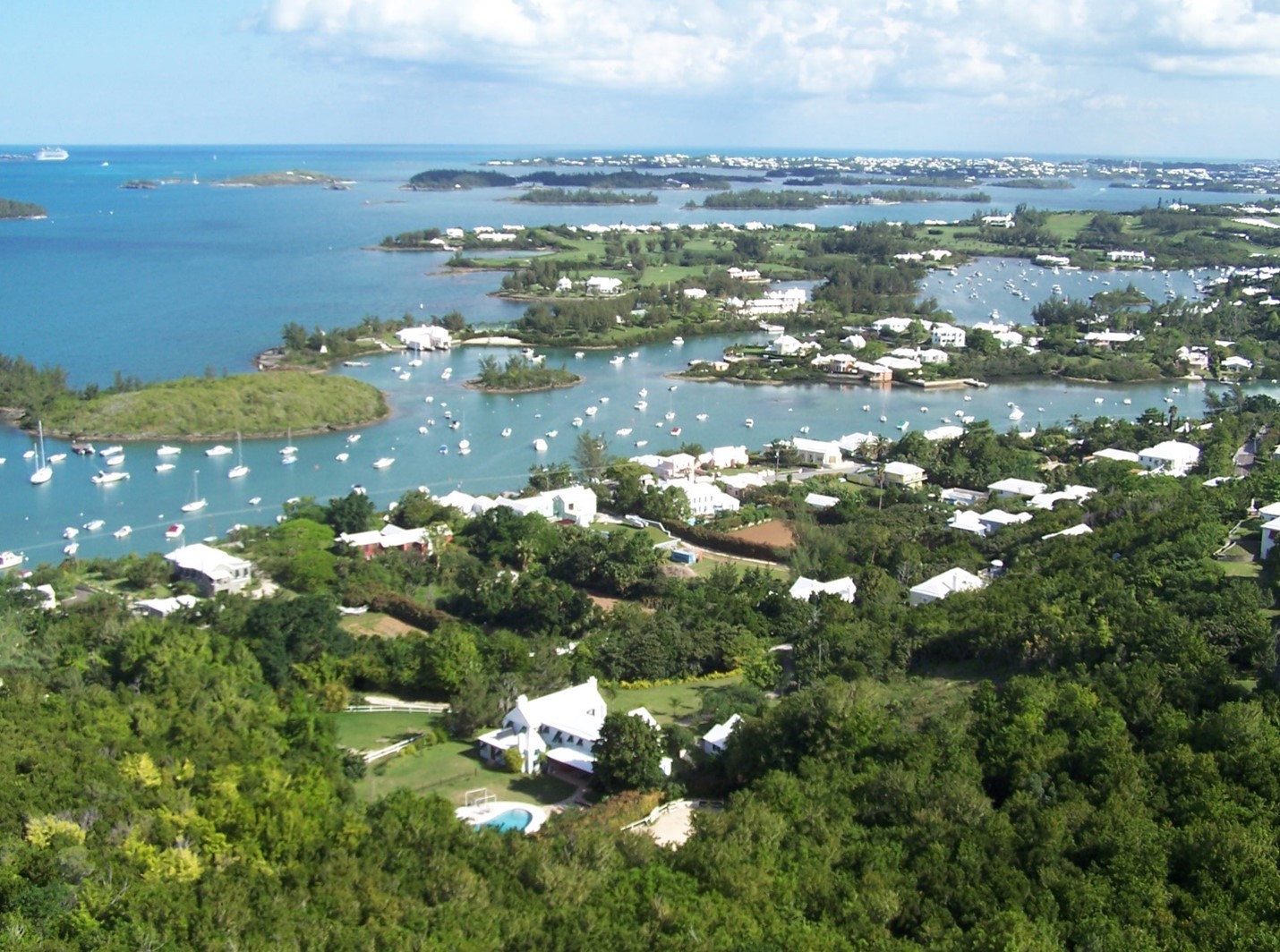Atlantic World Research
Atlantic World Research
 |
| The Powell House, 2nd Street Philadelphia. Considered one of the finest homes in 1760's Philadelphia, the Powell house was built by Charles Stedman part owner of Elizabeth Furnace. He was forced to sell it to Samuel Powell when he had financial difficulties in the early 1770's. |
The ultimate purpose of historical research is to uncover previously unknown information and to better understand the historical processes which shaped both the past and the present. The decision to conduct excavations at Elizabeth Furnace was initially influenced by a desire to explore the colonial period history of Lancaster County. However, our first year of research indicated that the importance of this site extended well beyond Lancaster County, and even Pennsylvania. Documentary investigation revealed that Charles & Alexander Stedman, brothers who owned 2/3 of the furnace, were also successful Philadelphia merchants. Examination of the furnace's records showed that the investment Charles and Alexander made in the furnace in 1756 was far more substantial than would have been prudent if the furnace's main markets were merely local or regional. The extent of the furnace village, all privately owned by the Stedman brothers and H.W. Stiegel, has been described by one historian as "industrial in scope, yet built during a pre-industrial period". What type of market did these two experienced merchants intend to tap into that prompted them to invest so much money in an ironworks? Why create such a large operation, particularly compared to other colonial period furnaces? Through intensive investigation of historical documents related to Elizabeth Furnace, including the furnace's ledgers, Henry William Stiegel's personal letters, and intensive analysis of deeds and wills, it was discovered that products of Elizabeth Furnace were being sold in Philadelphia and from there were being shipped to the West Indies. An Elizabeth Furnace Ledger provided evidence that a large sugar kettle had been returned, due to a casting flaw, from a buyer in the West Indies in 1769. In that same year Stiegel published the following advertisement in the Pennsylvania Gazette:
March 23, 1769 The Pennsylvania Gazette IRON CASTINGS, OF all dimensions and sizes, such as kettles or boilers for potash works, soap boilers pans, pots, from a barrel to 300 gallons, ship cabooses, skachels and sugar house stoves, with cast funnels of any height for refining sugars, weights of all sizes, grate bars, and other castings for sugar works in the West Indies, &c. are all carefully done by HENRY WILLIAM STIEGEL, iron master, at Elizabeth Furnace, in Lancaster county, on the most reasonable terms. Orders and applications made to MICHAEL HILLEGAS, in Second Street, Philadelphia, will be carefully forwarded. -- Many of the public being already well acquainted with the excellency of the iron of Elizabeth furnace for such purposes, renders it needless here to say any thing in its commendation. The said Stiegel begs leave further to inform the public, that his Glass Manufactory, in Manheim town, in the county aforesaid is again at work, where are made all sorts of bottles, window glass, and sheet glass; also retorts and other glasses for doctors and chymists. Orders, with proper directions, made to the said MICHAEL HILLEGAS, will likewise be forwarded by him to the said Manufactory with dispatch.
With this information in mind we began attempting to track iron from our Elizabeth Furnace to islands in the West Indies. A chance discussion with Dr. Clarence Maxwell, formerly of the Bermuda Maritime Museum and currently a member of the History Department Faculty at Millersville University, gave us some indication of where this iron was going.
 |
| Dr. Clarence Maxwell and Dr. Tim Trussell stand in a smugglers cave in Southhampton Bermuda. |
Dr. Maxwell's research focuses on illegal smuggling in Bermuda during the 18th-century. Utilizing documentary research and nautical archaeological investigation of shipwrecks, Dr. Maxwell found that Bermuda traders formed a key nexus in an Atlantic World trade which included illegal smuggling with French possessions in the Caribbean. When Dr. Maxwell learned of the Elizabeth Furnace research, he suggested that iron from Philadelphia may have my have played a role in this smuggling trade. He noted that bar iron was used as currency in West Africa, often in exchange for slaves, who were then sold throughout the Atlantic World. Additionally, he pointed out that the ironwork for sugar production made at Elizabeth Furnace would have been a highly profitable commodity to trade to sugar islands throughout the Caribbean, and particularly with the French sugar islands within the network of smuggling he was researching. With this new research angle in mind we began to look at Bermuda for evidence of a trade in iron between Philadelphia and Bermuda. We discovered that many merchant families in Bermuda had contacts with merchant families in Philadelphia, or were inter-married.
The British "Navigation Acts" placed high duties on sugar and molasses imported from the French colonies, creating a large incentive for American colonists to avoid such taxes through smuggling. With the start of the French and Indian War, smuggling became more dangerous. The larger, slower ships, that were common among Philadelphia merchants in the 1740-1750's were abandoned in favor of the smaller, but incredibly fast Bermuda sloops. Thus, Bermuda merchants, who had been trading illegally with the French for generations, began working even more closely with colonial merchants. Philadelphia traders benefited from this relationship because they could ensure that their cargoes would arrive safely and quickly. Bermuda sloops could out-run larger vessels that might seek to capture them, and had the ability to tack against the wind, allowing them to make good time even in less than ideal weather conditions.

As a result of these discoveries, we have begun a new phase in our analysis. We now view Elizabeth Furnace as a node of production, feeding into a trans-Atlantic network of distribution that includes both Philadelphia and Bermuda. To date we have been engaged in a thorough document search to reveal the role Philadelphia played in the Atlantic iron trade, both illicit and legitimate. Interestingly, it has proven exceptionally difficult to locate shipping manifests that list iron as a cargo, even when production records from Elizabeth Furnace note an average of nearly 80 tons of iron production per year being shipped to Philadelphia. This is not an altogether surprising gap in the documentary record if the trade was part of an illegal network. Tracing other forms of connection, such as merchant letters, business partnerships, and ship arrivals, has led us to the investigation of the Stiles and Dickinson families in Bermuda. These Bermuda merchant families had connections with Philadelphia merchants who, in turn, are linked through business partnerships, land transactions, or trade, to Elizabeth Furnace. Indeed, when Edward Stiles retired from trading as one of the wealthiest men in Bermuda, he moved to Philadelphia, naming his home "Port Royal" for the place in Southampton Parrish, Bermuda, where he was born.
Learn more about the Perot and Rectory research sites in Bermuda.